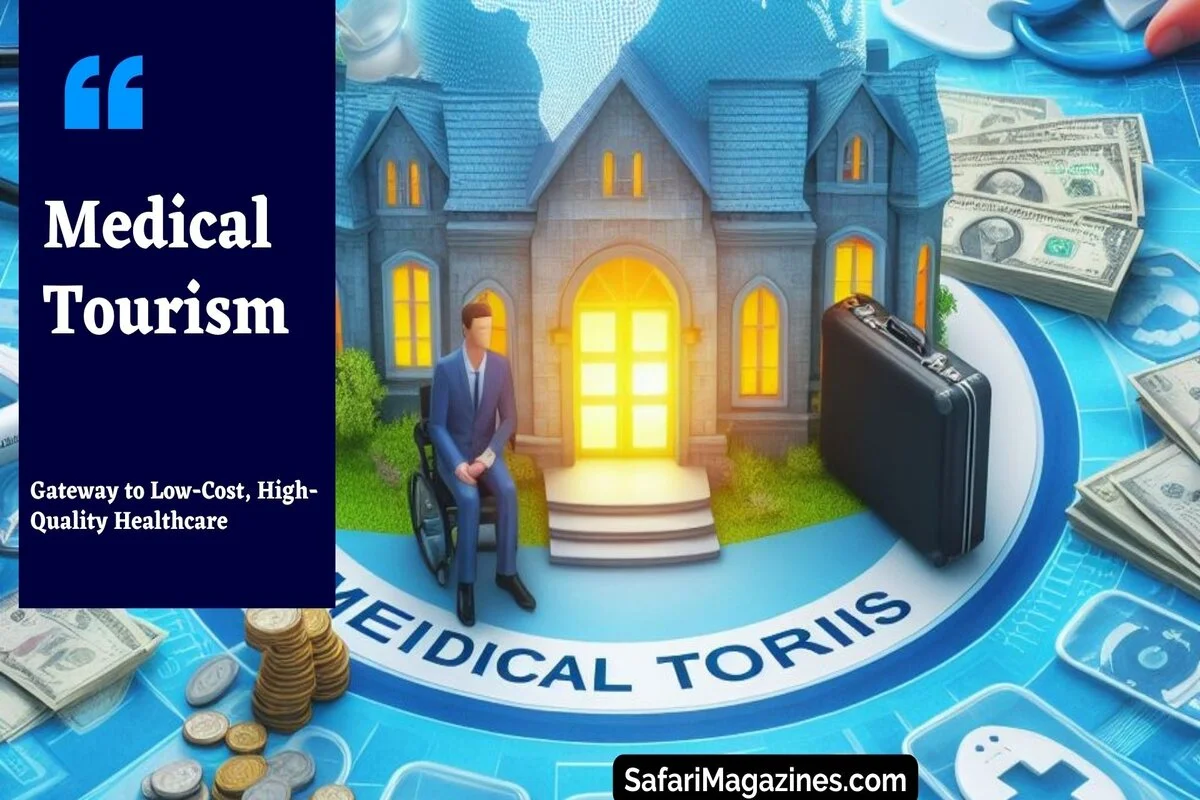
Medical Tourism, Gateway to Low-Cost and High-Quality Healthcare. Medical tourism is the act of traveling to another country for medical treatment. this type of tourism has gained immense popularity in recent years. This trend is driven by the desire for cost-effective health care, access to world-class medical facilities, and the opportunity to combine treatment with travel. In this article, we will explore the various aspects of medical tourism, from its advantages to popular destinations, types of treatments offered, quality standards, challenges, and future trends.
Table of Contents
ToggleAdvantages of Medical Tourism
Cost-effective Healthcare Options in Medical Tourism
One of the primary reasons individuals opt for medical tourism is the significant cost savings. Countries like India, Thailand, and Mexico offer medical procedures at a fraction of the cost compared to developed nations. This affordability factor, coupled with quality healthcare, attracts patients seeking various treatments.
Access to World-Class Medical Facilities
Medical tourism provides access to state-of-the-art medical facilities and highly skilled healthcare professionals.So, many renowned hospitals and clinics in popular medical tourism destinations are equipped with cutting-edge technology, ensuring patients receive top-notch treatment and care.
Combining Treatment with Travel in Medical Tourism
Medical tourism allows individuals to turn their healthcare journey into a travel experience. Patients can explore new cultures, cuisines, and scenic landscapes while undergoing medical treatments. This unique combination attracts those looking for a complete approach to their comfort.
Popular Medical Tourism Destinations
Thailand: The Land of Smiles for Medical Care
Thailand has emerged as a leading destination for medical tourists because of its hospitality. As well as Thailand offers a wide range of medical services, including plastic surgery, dental procedures and health treatments. The stunning beaches and vibrant culture adds to travelers’ appeal for healthcare.
India: Affordable Healthcare and Cultural Richness
India stands out for its cost-effective yet high-quality healthcare services. Patients from around the world seek medical treatments in India, attracted not only by the affordable prices but also by the rich cultural experiences the country has to offer. India’s diverse landscapes and historical sites make it a compelling destination for medical tourism.
Mexico: Geo Location and Quality Medical Services
Geographical location plays a crucial role in the popularity of Mexico as a medical tourism destination specially for individuals from the United States and Canada. Beyond geographical convenience, Mexico boasts accredited medical facilities providing a range of treatments, from cosmetic surgeries to advanced medical procedures.
Types of Medical Treatments Offered
Medical tourism caters to a broad spectrum of treatments, appealing to diverse healthcare needs.
Cosmetic Surgery
Cosmetic procedures such as facelifts, breast augmentations, and liposuction are among the most sought-after treatments in medical tourism. Patients often choose these procedures abroad to benefit from cost savings without compromising on quality.
Dental Procedures
Dental tourism is a significant aspect of medical travel, with individuals seeking dental implants, teeth whitening, and other oral treatments. Countries like Mexico and Thailand are popular choices for dental procedures due to their affordability and quality dental care.
Fertility Treatments
Patients facing challenges with fertility often explore medical tourism options for assisted reproductive technologies. Accessible treatments, coupled with the opportunity to relax in a new environment during the process, contribute to the appeal of fertility treatments abroad.
Bones Surgeries
Bones Surgeries or orthopedic procedures, including joint replacements and spinal surgeries, draw patients to medical tourism destinations known for specialized bones care. So, the combination of skilled surgeons and modern facilities positions these countries as attractive options for orthopedic treatments.
Continue Reading: Medical Tourism: Gateway to Low-Cost ,High-Quality Healthcare
Quality Standards and Accreditation in Medical Tourism
Ensuring the quality and safety of medical treatments in foreign countries is paramount. International accreditation of healthcare facilities is a key factor that instills confidence in medical tourists.
Importance of International Accreditation
Accreditation from internationally recognized bodies such as Joint Commission International (JCI) ensures that healthcare facilities meet rigorous quality standards. Prospective medical tourists should prioritize choosing accredited hospitals and clinics to guarantee a high standard of care.
Ensuring Patient Safety and Satisfaction
Stringent quality control measures, adherence to ethical practices, and transparent communication contribute to the overall safety and satisfaction of patients. Reputable medical tourism destinations prioritize these aspects to build trust and attract a global patient base.
Challenges in Medical Tourism
Despite the numerous advantages, medical tourism presents challenges that individuals should be aware of before embarking on their healthcare journey.
Language Barriers
Communication can be a significant challenge in medical tourism, especially when seeking healthcare services in a foreign country. Overcoming language barriers is crucial for effective doctor-patient communication and understanding treatment plans.
Legal and Ethical Concerns
Differing legal and ethical standards across countries may pose challenges for patients. Understanding the legal aspects of medical procedures, including liability and malpractice laws, is essential to navigate potential legal issues.
Post-Treatment Complications
Dealing with post-treatment complications can be challenging, particularly when patients return to their home countries. Coordination between healthcare providers in the destination and the patient’s local healthcare professionals is essential for comprehensive post-treatment care.
Continue Reading: Medical Tourism: Gateway to Low-Cost , High-Quality Healthcare
Tips for Planning a Medical Tourism Trip
Planning a medical tourism trip requires careful study to ensure a smooth and successful experience.
Researching Healthcare Providers
Thoroughly researching potential healthcare providers is crucial. This includes checking their accreditation, reading patient reviews, and understanding the expertise of the medical professionals who will be involved in the treatment.
Understanding the Local Culture and Regulations
Familiarizing oneself with the local culture and healthcare regulations is essential for a positive medical tourism experience. Understanding cultural nuances can facilitate better communication with healthcare providers and enhance the overall journey.
Budgeting for the Entire Trip
Creating a detailed budget that encompasses all aspects of the trip, including travel, accommodation, and medical expenses, is vital. Transparent pricing from healthcare providers and clear communication about additional costs can help avoid financial surprises.
Success Stories and Testimonials
Real-Life Experiences of Medical Tourists
The success stories of individuals who have received medical care abroad provide valuable ideas. These stories often highlight not only the positive medical outcomes but also the enriching travel experiences that accompany the healthcare journey.
Positive Impact on Patients’ Lives
Medical tourism has had a positive impact on the lives of many patients. Beyond the physical benefits of treatments, individuals often return home with a newfound sense of well-being, having received nice medical care in a new and culturally rich environment.
Impact of COVID-19 on Medical Tourism
The global pandemic has significantly impacted the landscape of medical tourism.
Travel Restrictions and Safety Measures
Travel restrictions and safety concerns related to the pandemic have disrupted the plans of many prospective medical tourists. Understanding the current travel landscape and healthcare protocols is essential for those considering medical tourism in the post-pandemic era.
The Rise of Telemedicine in the Industry
The adoption of telemedicine has become more prevalent in the medical tourism industry. Virtual consultations and follow-ups provide a convenient and safe alternative, allowing patients to connect with healthcare professionals without physical travel.
Continue Reading: Medical Tourism: Gateway to Low-Cost, High-Quality Healthcare
Future Trends in Medical Tourism
The medical tourism industry increased and there are many trends shaping its future.
Technological Advancements
Advances in medical technology, including robotics and artificial intelligence, are changing the environment of health care. Medical tourism destinations that include these technological innovations are likely to attract a growing number of health-conscious travelers.
Increased Collaboration Between Countries
Countries are increasingly recognizing the economic potential of medical tourism and are enhancing collaborations to improve their health care offerings. International partnerships can lead to the sharing of medical expertise and resources, which will ultimately benefit patients.
Shifting Preferences and Expectations
As the demographics of medical tourists improve, preferences and expectations change. Patients are placing greater emphasis on total care, personalized treatment plans, and wellness experiences. Medical tourism destinations that adapt to these changing preferences will stay competitive.
Read More : Sports Tourism: A Journey Beyond the Game
Conclusion
In conclusion, medical tourism provides a unique opportunity for individuals to access high-quality, affordable healthcare while exploring new destinations. The advantages, ranging from cost-effective treatments to the opportunity to combine healthcare with travel, make medical tourism an attractive option. However, potential challenges, such as language obstacles and legal considerations, should be carefully navigated. With proper research and planning, medical tourism can be a satisfying and transformative experience.
Frequently Asked Questions (FAQs)
- Is medical tourism a safe option for treatments?
- Medical tourism can be safe if patients thoroughly research and choose accredited healthcare providers. Adhering to safety protocols and transparent communication with healthcare professionals is essential.
- How can language barriers be overcome in medical tourism?
- To overcome language barriers, patients can seek healthcare providers with multilingual staff or use translation services. Clear communication before and during the treatment process is crucial.
- What impact has COVID-19 had on the medical tourism industry?
- COVID-19 has led to travel restrictions and safety measures, affecting the plans of many medical tourists. The industry has also witnessed a rise in telemedicine as an alternative to in-person consultations.
- Are there financial risks associated with medical tourism?
- While medical tourism can offer cost savings, patients should be aware of potential additional costs. Transparent pricing, thorough budgeting, and understanding refund policies can mitigate financial risks.
- What are the future trends in the medical tourism industry?
- Future trends in medical tourism include technological advancements, increased collaboration between countries, and evolving patient preferences. These trends are shaping the industry’s landscape and patient experiences.
